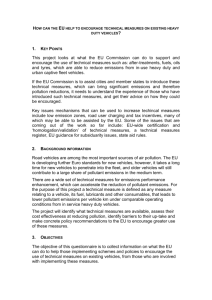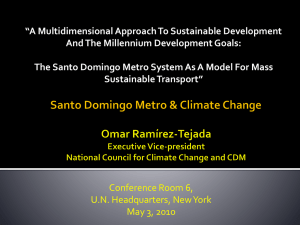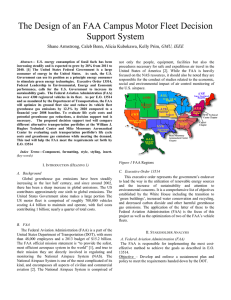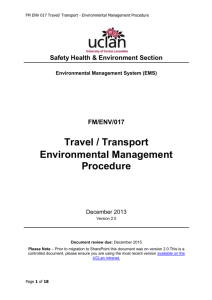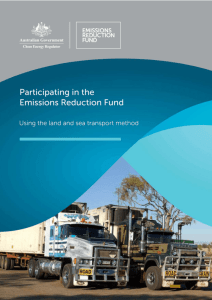Hannah Duncan-Jones + Nicola Ward on transport emissions
advertisement
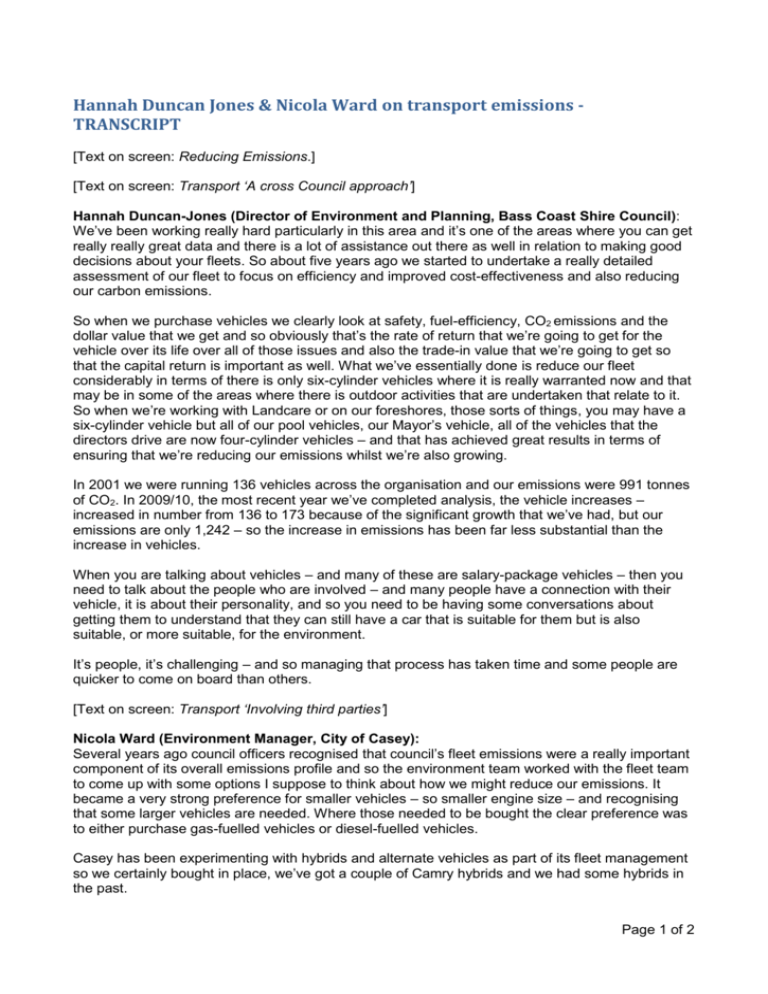
Hannah Duncan Jones & Nicola Ward on transport emissions TRANSCRIPT [Text on screen: Reducing Emissions.] [Text on screen: Transport ‘A cross Council approach’] Hannah Duncan-Jones (Director of Environment and Planning, Bass Coast Shire Council): We’ve been working really hard particularly in this area and it’s one of the areas where you can get really really great data and there is a lot of assistance out there as well in relation to making good decisions about your fleets. So about five years ago we started to undertake a really detailed assessment of our fleet to focus on efficiency and improved cost-effectiveness and also reducing our carbon emissions. So when we purchase vehicles we clearly look at safety, fuel-efficiency, CO2 emissions and the dollar value that we get and so obviously that’s the rate of return that we’re going to get for the vehicle over its life over all of those issues and also the trade-in value that we’re going to get so that the capital return is important as well. What we’ve essentially done is reduce our fleet considerably in terms of there is only six-cylinder vehicles where it is really warranted now and that may be in some of the areas where there is outdoor activities that are undertaken that relate to it. So when we’re working with Landcare or on our foreshores, those sorts of things, you may have a six-cylinder vehicle but all of our pool vehicles, our Mayor’s vehicle, all of the vehicles that the directors drive are now four-cylinder vehicles – and that has achieved great results in terms of ensuring that we’re reducing our emissions whilst we’re also growing. In 2001 we were running 136 vehicles across the organisation and our emissions were 991 tonnes of CO2. In 2009/10, the most recent year we’ve completed analysis, the vehicle increases – increased in number from 136 to 173 because of the significant growth that we’ve had, but our emissions are only 1,242 – so the increase in emissions has been far less substantial than the increase in vehicles. When you are talking about vehicles – and many of these are salary-package vehicles – then you need to talk about the people who are involved – and many people have a connection with their vehicle, it is about their personality, and so you need to be having some conversations about getting them to understand that they can still have a car that is suitable for them but is also suitable, or more suitable, for the environment. It’s people, it’s challenging – and so managing that process has taken time and some people are quicker to come on board than others. [Text on screen: Transport ‘Involving third parties’] Nicola Ward (Environment Manager, City of Casey): Several years ago council officers recognised that council’s fleet emissions were a really important component of its overall emissions profile and so the environment team worked with the fleet team to come up with some options I suppose to think about how we might reduce our emissions. It became a very strong preference for smaller vehicles – so smaller engine size – and recognising that some larger vehicles are needed. Where those needed to be bought the clear preference was to either purchase gas-fuelled vehicles or diesel-fuelled vehicles. Casey has been experimenting with hybrids and alternate vehicles as part of its fleet management so we certainly bought in place, we’ve got a couple of Camry hybrids and we had some hybrids in the past. Page 1 of 2 Hannah Duncan Jones & Nicola Ward on transport emissions - TRANSCRIPT One of the things we’ve recognised at Casey is that council doesn’t do everything. Councils often contract out a lot of tasks or services that it undertakes to provide to its residents and one of these is waste management obviously. What our waste department decided to think about as the new contracts for waste management were coming up were putting in some clauses in that tender to specify that Casey is really interested in proposals coming through that demonstrate environmental credentials. So by putting that clause in the tender – but without specifying what type of outcomes we were looking for – it gave an opportunity for a successful tenderer to demonstrate their environmental credentials by offering as part of the tender to use compressed natural gas vehicles. And we’re really starting to see the benefits of that now. The first decisions were probably made four or five years ago now and even with an increase in our vehicle fleet and an increase in kilometres we’re starting to see those emissions level off. [Image fades. Video ends.] Duration: 4:29 SOURCE: http://www.mav.asn.au/policy-services/environment/climate-change/emissionsreduction-and-mitigation/Pages/default.aspx https://vimeo.com/39315906 Page 2 of 2



